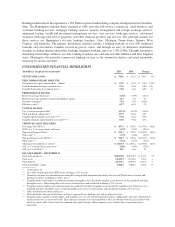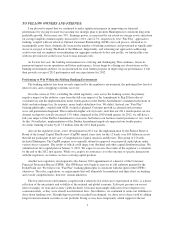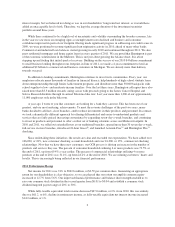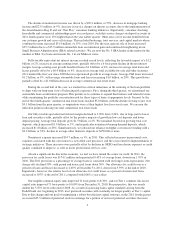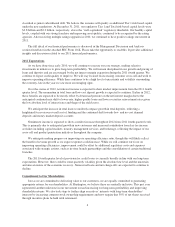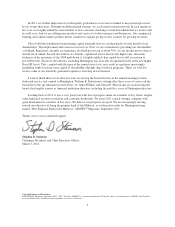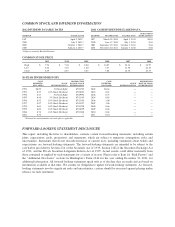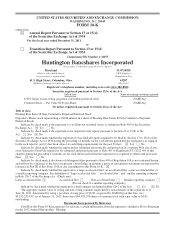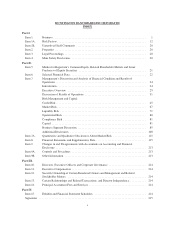Huntington National Bank 2011 Annual Report Download - page 4
Download and view the complete annual report
Please find page 4 of the 2011 Huntington National Bank annual report below. You can navigate through the pages in the report by either clicking on the pages listed below, or by using the keyword search tool below to find specific information within the annual report.
interest margin, but we believed not doing so was in our shareholders’ long-term best interest, as it would have
added an unacceptable level of risk. Therefore, we kept the average duration of the investment securities
portfolio around three years.
While there continued to be a high level of uncertainty and volatility surrounding the broader economy, late
in the year we saw more encouraging signs as unemployment rates declined and business and consumer
confidence improved in parts of our footprint. Having made significant progress in addressing our credit issues in
2009, we were positioned to resume significant loan origination activity in 2010, ahead of many other banks.
Commercial and industrial loan balances started growing in early 2010 and continued throughout 2011. We also
grew residential mortgages and home equity loans in every quarter of 2011. We are proud that Huntington is part
of the economic solution here in the Midwest. This is not just about growing the balance sheet. It is about
stepping up and fueling that initial spark of recovery. Building on the success of our 2010 $4 billion commitment
to small business lending throughout our footprint, in June of 2011, we made a 4-year commitment to lend an
additional $2 billion to commercial and business customers in Michigan. We are already more than halfway
towards our goal.
In addition to lending commitments, Huntington continues to invest in its communities. Every year, our
employees educate many thousands of families in financial literacy, help hundreds of high school students learn
about entrepreneurship through Junior Achievement programs, and distribute more than 30,000 backpacks with
school supplies to low- and moderate-income families. Over the last three years, Huntington colleagues have also
raised more than $3.5 million towards curing cancer with proceeds going to the James Cancer Hospital and
Solove Research Institute through its annual Pelotonia bike tour. Last year more than 1,000 of our approximately
11,000 employees rode in the bike tour.
A year ago, I wrote to you that customers are looking for a bank they can trust. This has been one of our
greatest, and our most enduring, achievements. To meet the revenue challenges of the past two years, many
banks decided to add fees, close branches, and/or reduce investments in their products and personnel. In contrast,
we took a dramatically different approach by offering differentiated and easier-to-understand products and
services that are fairly priced, increasing convenience by expanding seven-day-a-week branches, and continuing
to invest in products and personnel to offer a robust set of banking solutions across our Midwest footprint. In
2010 and 2011, we rolled out extended hours at our traditional branches, opened more than 30 seven-day-a-week,
full-service in-store branches, introduced 24-hour Grace®, and launched Asterisk-Free™and Huntington Plus™
checking.
Since undertaking these initiatives, the results are clear and exceeded our expectations. We have added over
166,000, or 18%, new consumer checking account households and over 16,000, or 13%, commercial checking
relationships. Now that we have these new customers, our OCR process is driving an increase in the number of
products and services they use. The percent of consumer households utilizing 4 or more products was 73.5% at
the end of 2011, up from 69.4% a year earlier. The percent of commercial relationships utilizing 4 or more
products at the end of 2011 was 31.4%, up from 24.2% at the end of 2010. We are winning customers’ hearts and
loyalty. This is increasingly being reflected in our financial performance.
2011 Performance Recap
Net income for 2011 rose 74% to $542.6 million, or $0.59 per common share. Generating an appropriate
return for our shareholders is a key objective, so we are pleased that our return on tangible common equity
increased to 12.7% from 5.6%. Our improved financial performance and balance sheet strength enabled us to
raise our common stock dividend in the second quarter from $0.01 to $0.04 and establish a common stock
dividend targeted payout range of 20% to 30%.
While fully-taxable equivalent total revenue decreased $47.0 million, or 2%, from 2010, this was entirely
due to a $61.2, or 6%, decline in noninterest income, as fully-taxable equivalent net interest income increased
$14.2 million, or 1%.
2


